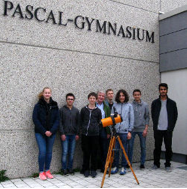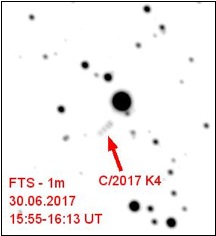-
Faulkes Telescope Project Privacy Policy
A new school sport: Hunting for asteroids!
A new school teacher member of the Faulkes Telescope Project, Paul Breiteinstein from Germany, has been working hard with his students, spotting asteroids. Below he tells us all about their new hobby!
Our new school sport: hunting asteroids!
By Paul Breitenstein
 Since 2012 the Pascal-Gymnasium in Münster (Germany) has been running the AiM project. AiM stands for “Astronomy and internet in Münster”. Our real aim is using the modern possibilities provided by the Internet to make astronomical and astrophysical discoveries.
Since 2012 the Pascal-Gymnasium in Münster (Germany) has been running the AiM project. AiM stands for “Astronomy and internet in Münster”. Our real aim is using the modern possibilities provided by the Internet to make astronomical and astrophysical discoveries.
At our school we only have the possibility using an old 8 inch Celestron reflector, a small Coronado solar refractor and a little Newtonian telescope. But the biggest problem is
the high humidity, clouds and light pollution in our home town. Also in summer we have short nights, and in winter cold nights. So we have looked for better options.
In co-operation with the University of Göttingen (Germany) we have already worked with MONET (MOnitoring NEtwork of Telescopes) – two 1.2m Ritchey-Chretien-telescopes, one at McDonald Observatory in Texas/US and the other at the South African Astronomical Observatory in Sutherland (South Africa). Later we used the 0.4m Bradford Robotic Telescope on Mt. Teide (Tenerife) to observe the Mira-type variable NSV 24959 (the “Goldilocks Variable” – see: https://www.aavso.org/vsx/index.php?view=detail.top&oid=63394).
Since the beginning of 2017 the House of Astronomy in Heidelberg (Germany) gave us the chance of using the Faulkes Telescopes, and we were very surprised about the good and solid support we received.
 We got hooked on tracking asteroids by different campaigns with the IASC (International Astronomical Search Collaboration), an educational outreach program for high schools and colleges working with the Pan-STARRS telescope on Mt. Haleakala (Hawaii). So the idea of our own asteroid tracking program was born, and we are now involved in the discoveries of the NEOs (Near-Earth-Object) 2017FL101, 2017HB1 and 2017KR34 by confirmation, as well as in the re-discovery of 2009HS9. Furthermore we confirmed the newly discovered comets P/2017K3, C/2017K4 and C/2017M5 (see: http://pascal.nw.lo-net2.de/aim3/.ws_gen/?10).
We got hooked on tracking asteroids by different campaigns with the IASC (International Astronomical Search Collaboration), an educational outreach program for high schools and colleges working with the Pan-STARRS telescope on Mt. Haleakala (Hawaii). So the idea of our own asteroid tracking program was born, and we are now involved in the discoveries of the NEOs (Near-Earth-Object) 2017FL101, 2017HB1 and 2017KR34 by confirmation, as well as in the re-discovery of 2009HS9. Furthermore we confirmed the newly discovered comets P/2017K3, C/2017K4 and C/2017M5 (see: http://pascal.nw.lo-net2.de/aim3/.ws_gen/?10).
One of our main projects is the tracking of comets P/2017K3 and C/2017K4, as well as asteroid 2017KR34, until the end of this year. These NEOs are moving relatively slowly
and parallel to the Earth.
The absolute highlight would be our own discovery of an unknown asteroid or comet. We are out of luck until now, but we are confident.
Thanks for the great support of the FT-team!
Posted in News
